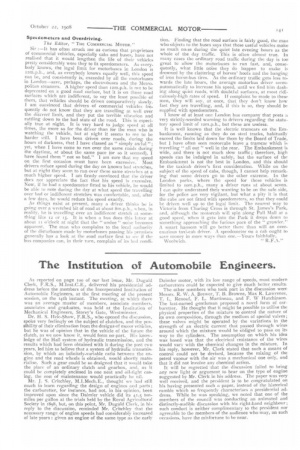The Institution of Automobile Engineers.
Page 15

If you've noticed an error in this article please click here to report it so we can fix it.
As reported on page too of our last issue, Mr. Dug-alti Clerk, E.R.S., M.Inst.C.E., delivered his presidential address before the members of the Incorporated Institution of Automobile Engineers, at the first meeting of the present session, on the nith instant. The meeting, at which there was an average muster of members, associate members, associates and graduates, was held at the Institution of Mechanical Engineers, Storey's Gate, Westminster.
Dr. H. S. Heie-Shaw, E.R.S., who opened the discussion, spoke very feelingly on the subject of clutches, and the possibility of their elimination from the designs of motor vehicles, but he was of opinion that in the vehicle of the future the clutch, as we now know it, would form no part. His knowledge of the Hall system of hydraulic transmission, and the results which had been obtained with it during the past two years, led him to believe that a system of hydraulic transmission, by which an infinitely-variable ratio between the engine and the road wheels is obtained, would shortly materialise. Such a gear could he so designed that it would take the place of an ordinary clutch and gearbox, and, as it could be completely enclosed in one neat and oil-tight casing, the cost of maintenance would practically he nil.
Mr. J. S. Critchley, M.I.Mech.E., thought we had still much to learn regarding the design of engines and parts; the carburetter, for instance, had not, in his opinion, been improved upon since the Daimler vehicle did its 41.5 tonmiles per gallon at the trials held by the Royal Agricultural Society in 1898, but, on this point, Mr. Dug-ald Clerk, in his reply to the discussion, reminded Mr. Critchley that the necessary range of engine speeds had considerably increased of late years : given an engine of the same type as the early
Daimler motor, with its low range of speeds, most modern carburetters could be expected to give much better results. The other members who took part in the discUssion were Messrs. R. W. A. Brewer, T. B. Browne, Max R. Lawrence, L. Renouf, F. L. Martineau, and F. W Hutchinson. The last-named gentleman proposed a novel form of carburetter. He thought that it might be possible to utilise the physical •properties of the mixture to control the nature of its own composition, through the medium of special valves; these valves might be operated by • the variations in the strength of an electric current that passed through wires around which the mixture would he obliged to pass on its way to the cylinders. The assumption on which his idea was based was that the electrical resistance of the wires would vary with the chemical changes in the mixture. In his reply, however, Mr. Clerk stated that such a means of control could not be devised, because the mixing of the petrol vapour with the air was a mechanical one only, and that it did not involve any chemical action.
It will be regretted that the discussion failed to bring any new light or argument to bear on the type of engine suggested by Mr. Clerk in his address. The paper was very well received, and the president is to be congratulated on his having presented such a paper, instead of the historical ramble which so frequently characterises a presidential address. While he was speaking, we noted that one of the members of the council was conducting an animated and distinctly-audible discussion with his right-hand neighbour; such conduct is neither complimentary to the president nor agreeable to the members of the audience who may, on such occasions, have the misfortune to be near.




















